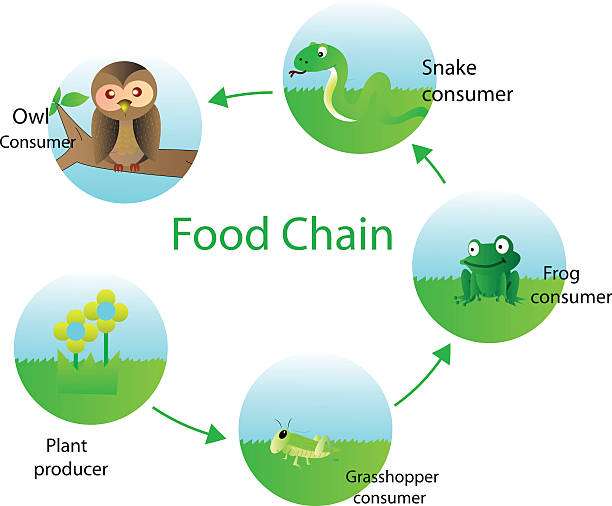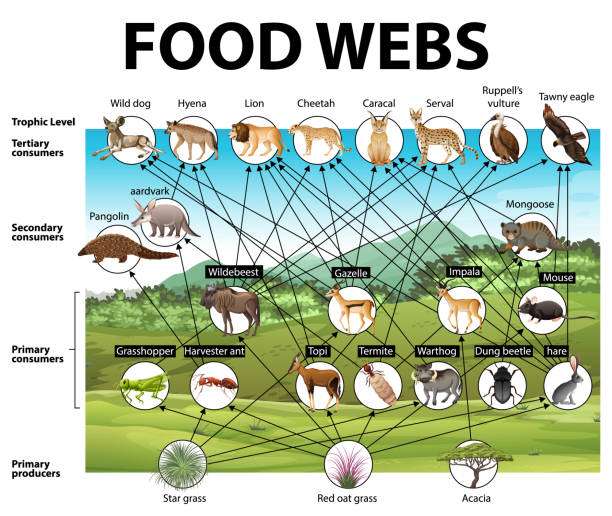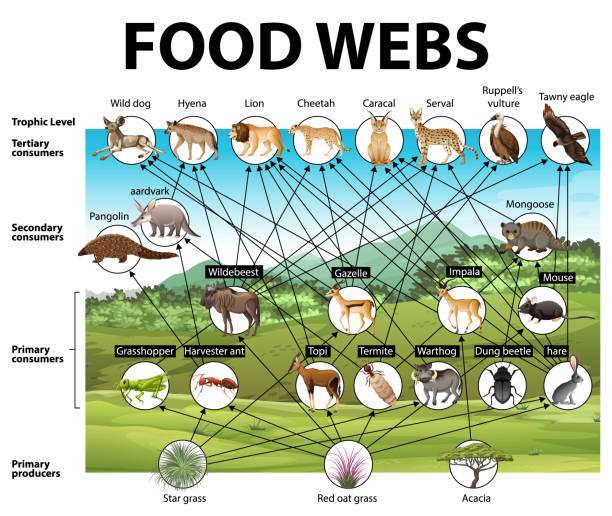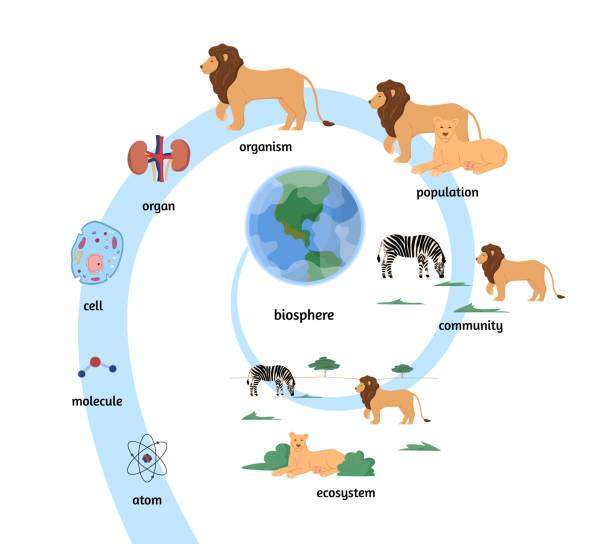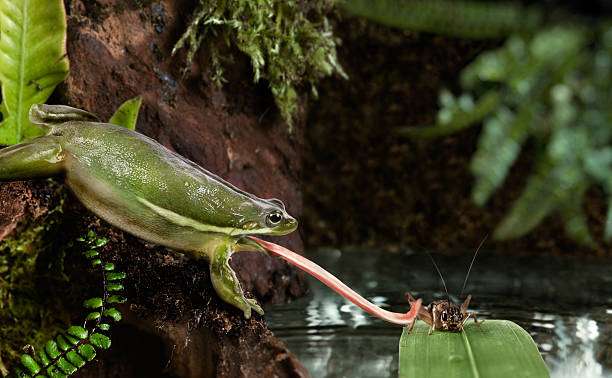Interpreting Food Chain Diagrams Understand the Basic Components and Glean Insight
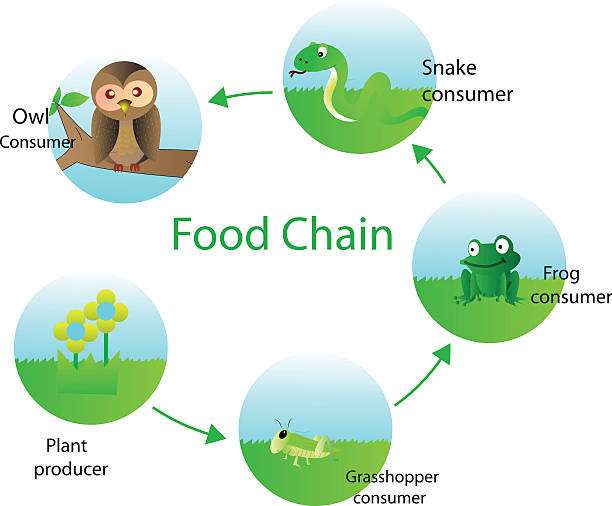
October 14, 2023
Are you trying to understand how to interpret food chain diagrams? If so, you’ve come to the right place. In this blog post, we’ll discuss how to read and understand food chain diagrams so that you can gain insight into the complex web of relationships between species in an ecosystem. We’ll look at how to identify the different species involved in each chain and what information can be gleaned from these diagrams. So let’s dive in and gain a better understanding of food chain diagrams!
How to Interpret Food Chain Diagrams
Food chain diagrams are an essential tool in understanding the different elements and relationships in any given food web. By illustrating the flow of energy within an ecosystem, food chain diagrams provide a snapshot of the complexity and stability of any system.
A food chain diagram is a graphic representation of how energy moves from one organism to another in a food web. The diagram consists of several arrows connecting the different organisms in the environment. Each arrow represents energy transfer from one organism to another. The arrows also illustrate the feeding relationships between the different species.
At the top of the food chain diagram is the primary producer. Primary producers are the base of the food chain, as they are capable of photosynthesizing and turning sunlight into energy. Primary producers are the only organisms that create their own energy. Some examples of primary producers in an ecosystem may include plants and phytoplankton.
Further down the food chain, you will find the primary consumers. These are organisms that feed directly on the primary producers, such as herbivores (such as grazing animals) and detritivores (such as detritivorous worms). Secondary consumers feed on the primary consumers, and tertiary consumers feed on the secondary consumers. At the very top of the food chain are the top predators, which feed on the tertiary consumers.
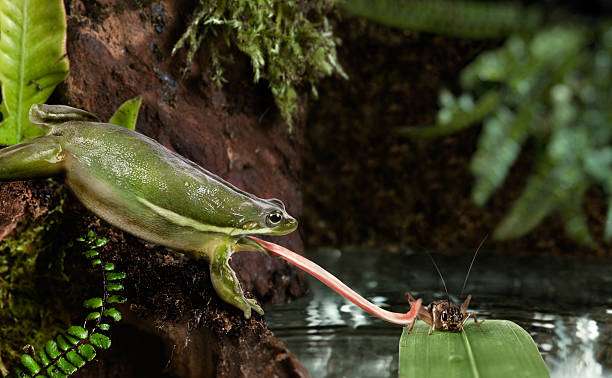
When interpreting food chain diagrams, it is important to consider the type and number of arrows that are used. The arrows indicate the flow of energy from one organism to another. If there are many arrows, this suggests that the food web is complex and contains many interconnected species. If there are fewer arrows, this suggests that the food web is simpler and has fewer relationships between species.
It is also important to consider the size of the arrows. Larger arrows signify that energy is flowing from a larger and more established organism, such as a top predator, to a smaller organism, such as a primary producer. Smaller arrows signify that energy is flowing from smaller and less established organisms, such as primary consumers, to larger and more established organisms, such as the top predator.
In summary, food chain diagrams can be a useful tool in understanding the complexity and stability of an ecosystem. By interpreting the arrows and their relative sizes, you can gain an insight into the relationships between species and the flow of energy within the environment.
We live in a world full of interconnected systems: food webs, ecosystems, and more. One of the most important and complex of these is the food chain. Understanding food chains is essential to understanding the interconnectedness of nature and its impact on the environment.
Food chains are diagrams that illustrate the relationships between different organisms in a system. At the base of a food chain are the producers, which are usually plants, as they use the energy from the sun to produce food. Then there are consumers, which can either be herbivores, who only feed on plants, or carnivores, which feed on other animals. Higher up in the chain are predators, which feed on other animals, and higher still are apex predators, which have no predators themselves.
Food chains are full of interconnected elements, as the transfer of energy from organism to organism is essential for life to persist. It is only when we understand the processes of a food chain that we can begin to understand the importance of this complex system. We can use food chain diagrams to help us visualize the various relationships between organisms.
Food chain diagrams are made up of a range of components, from producers and consumers to predators and apex predators. They also utilize various symbols to illustrate the energy pathways between the various species, and their energy flow. The structure of a food chain diagram is also important, as it allows us to trace the energy transfer from one organism to the next. We can also use them to identify producer and consumer relationships and to analyze predator and prey relationships.
Lastly, food chain diagrams can also help us to understand the significance of these interconnected systems. They can be used to examine the effects of human activity on the environment, investigate the complex dynamics of food webs, recognize the roles of decomposers in food chains, and more.
Understanding and interpreting food chain diagrams is essential to understanding the interconnected nature of life and its role in sustaining the environment. It is only when we comprehend the importance of food chains and the processes that occur within them that we can begin to have a deeper appreciation of the natural world.
Interpreting food chain diagrams involves exploring the interconnected nature of food chains, recognizing the components of these chains, analyzing energy pathways, and studying the relationships between species. Food chain diagrams provide visual representations of the processes of food chains, their producer/consumer relationships, their predator/prey relationships, the transfer of energy, and the role of nutrients. These diagrams also help to illustrate how sun energy, human activity, and natural events can all affect food chains and how they adapt over time. Additionally, food chain diagrams can help to uncover the complex dynamics of food webs and the role of decomposers. Ultimately, understanding the importance of food chain diagrams can be crucial for examining the energies needed to sustain life.
Unpacking the Basics: How to Interpret a Food Chain Diagram
Food chains are vital to the balance of nature, allowing energy to move through the food web. Interpreting a food chain diagram can help us understand how organisms are interconnected in an ecosystem.
A food chain diagram is an illustration of the transfer of energy between different species or organisms. It is helpful to think in terms of producers, consumers, and decomposers when interpreting a food chain. Producers are organisms that produce their own food—plants, for example. Consumers are organisms that feed on producers, such as herbivores. Decomposers are organisms that break down dead organic matter, such as fungi and bacteria.
Food chain diagrams often begin with a producer and then move up the chain to other levels of the food chain. For example, in the diagram above, the producer is a plant. The consumers are herbivores, such as the rabbit, deer, and mouse. The next level of the food chain is the carnivores, like the fox, eagle, and snake, who feed on the herbivores. And the top of the food chain is the apex predator, the mountain lion, who feeds on both herbivores and other carnivores.

In a food chain diagram, arrows are used to indicate the flow of energy through the food web. For example, in the above diagram, sunlight is the source of energy that powers the producers. The arrow points away from the producer and toward the consumer, indicating that the energy from the producer is transferred to the consumer. This flow of energy continues through the food chain, with the arrows indicating the transfer of energy from one organism to the next.
When interpreting a food chain diagram, it is important to remember that energy is lost as it moves through the food chain. This is because some energy is used by the organism for growth or other activities, and some energy is lost as heat. Therefore, there is a decrease in the total energy as it moves through the food chain.
Another important concept to remember when interpreting a food chain diagram is the concept of competition. In an ecosystem, organisms compete for resources such as food, space, and shelter. In a food chain, competition can occur between organisms at the same level or between organisms at different levels. For example, in the diagram above, the deer, mouse, and rabbit are all competing for the same plant resources.
Learning to interpret a food chain diagram can help us understand how an ecosystem works and the various interactions between species. It is important to remember that an ecosystem is a complex and interconnected system, and energy flows in different directions within it. A food chain diagram is a helpful tool for visualizing the flow of energy within an ecosystem.
Exploring the Interconnected Nature of Food Chains
Food chains are the intricate networks of producers, consumers, and decomposers that allow ecosystems to operate and provide sustenance to life on Earth. They are a fascinating interconnected system wherein each group of organisms relies on the other to survive.
At the base of food chains, there are producers such as plants, algae, and phytoplankton. These primary producers are vital to a functioning food chain, as they generate energy and nutrients through photosynthesis. This energy and nutrition is then passed up the food chain through primary consumers like herbivores and omnivores and ultimately ends up with apex predators on the top of the food chain. The apex predators are particularly important, as they help keep the balance in food webs by keeping populations of prey organisms and their competition in check.
In addition, food chains are connected to each other in a variety of ways. For example, the output of one food chain may be the input of another. This is known as energy flow, where energy from one organism is passed to the next in the form of nutrients. Also, predators may consume prey from more than just one food chain, which allows for the energy and nutrients to flow between different food webs. This means that if something were to happen to one food chain, it could affect the entire interconnected network.
The interconnectedness of food chains also shows just how important conservation is. Every link in the food chain is essential to the success of the entire ecosystem, and any disruption to one part can have
catastrophic consequences for the entire community. By protecting and restoring the habitats of species, we can ensure the health of our ecosystems and the sustainability of our food chains.
In conclusion, food chains are fascinating networks that are intricately linked and provide essential nutrients to support life on Earth. Through understanding this interconnected nature, we can ensure that our ecosystems are healthy and sustainable for generations to come.
What Is a Food Chain? A Guide to Understanding the Basics
A food chain is a linear flow of energy that begins with a producer, such as a plant and continues through a series of organisms as the energy passes from one trophic level to the next. It’s a fundamental concept in ecology, used to show how energy is transferred from one species to the next in a particular environment.
At the base of the food chain is the producer, a species that obtains energy directly from the environment to produce food. Plants, algae, and other photosynthetic organisms are producers, and these are the only species that produce their own food. Primary consumers are next in the food chain and they obtain energy by eating producers. These can be herbivores like deer, rabbits, or koalas. Secondary consumers, such as foxes and owls, are next and they get their energy by eating primary consumers and producers. Tertiary consumers, like bears and humans, are the top predators in the food chain and they obtain their energy by eating secondary consumers.
As energy passes through the food chain, some of it is used up as heat, and some of it is used to fuel the metabolism of the organism, maintaining life processes such as growth and reproduction. This is why the energy at the top of the food chain is less than what was originally present at the bottom.
It’s important to note that a food chain is only a representation of a particular system, and in reality, food webs are much more complex. In a more accurate portrayal, organisms can have multiple roles, and there are complex interactions between species at each level.
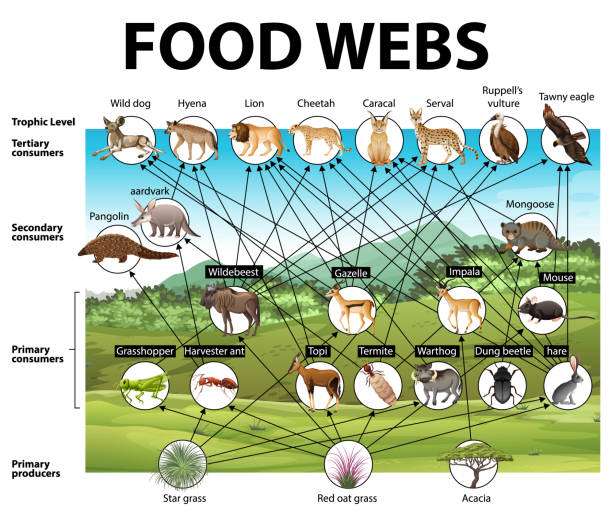
A food chain is a useful tool for understanding the flow of energy in a particular environment. It can be used to show how energy is transferred from one species to another and how energy is lost in the process. It can also be used to help identify each species’ role in the system and how they interact with one another. Understanding a food chain can help us identify potential issues with a system, such as the potential for an invasive species to throw off the balance of the food web.
How Can We Understand Food Chains Through Diagrams?
Food chains are an important concept in ecology that provides us with insight into how energy is transferred through an ecosystem and what species depend on one another for survival. Diagrams can be a powerful tool to help visualize these complex relationships. By understanding food chains through diagrams, we can get a clearer picture of how food webs interact with each other and how they impact the environment.
In a food chain diagram, each organism is represented by a box or circle. These shapes are then connected by arrows to illustrate the energy flow from one organism to the next. The arrows represent the flow of energy from an organism’s prey to the organism itself, and then to the organism’s predators. In a food web diagram, each organism is connected to multiple other organisms, indicating the multiple pathways of energy transfer within the ecosystem.
The arrows can be further annotated to represent the type of energy transfer that takes place. For example, the arrow pointing to an organism may indicate either a predator-prey relationship, a parasitism relationship, or a mutualism relationship. Each of these arrows helps to illustrate how different species depend on one another and how they drive the energy flow in an ecosystem.
In addition, food chain diagrams will often include labels to indicate the species or organisms represented by the boxes and circles. This can provide further understanding of the interactions between different types of species and help us identify keystone species, species that have a disproportionate effect on the ecosystem. By understanding food chains through diagrams, we can better understand the importance of different organisms within an ecosystem and how they influence the environment.
Finally, food chain diagrams are also helpful in understanding how human activities can affect an ecosystem and the species within it. By understanding the dynamics of the food web, we can better understand how our actions may disrupt the flow of energy within an ecosystem and how it could have a detrimental impact on the environment.
Overall, food chain and food web diagrams are valuable tools in helping us comprehend the complex relationships between organisms in an ecosystem. By understanding these relationships through diagrams, we can better understand how energy is transferred within ecosystems and how various species and human activities impact the environment.
Breaking Down the Components of a Food Chain Diagram
The food chain is one of the most important concepts in biology. It is a diagram that shows how energy, in the form of food, flows from one organism to another in an ecosystem. It helps to explain how the components of an ecosystem are interconnected and helps us to understand the complex relationship among organisms.
At the base of the food chain is the primary producer, such as a plant or algae. These organisms convert solar energy into energy that other organisms can use. This energy then moves up the food chain, from the primary producer to the primary consumer, then the secondary consumer, the tertiary consumer, and so on.
The primary consumers are usually herbivores, such as deer or rabbits, who consume the plants and algae. The secondary consumer is another animal that consumes the primary consumer. Examples of secondary consumers are carnivores such as tigers, wolves, or hawks. The tertiary consumer is any animal that eats the secondary consumer, such as a human.
Primary consumers, sometimes called consumers, eat plants or algae. secondary consumers eat primary consumers. Top predators eat tertiary consumers, and decomposers eat dead material.
Each creature on the food chain provides energy to the next creature. This energy can be in the form of food, such as plants or algae. The energy is also passed on in the form of waste, which is consumed by decomposers.
At the top of the food chain is the apex predator, which has no predators of its own. These predators can have an enormous impact on an ecosystem, as they keep the populations of other animals in check.
The food chain is constantly changing. New organisms are introduced, species become extinct, and populations shift. It is important to keep track of these changes, as they can have a huge effect on the environment.

Finally, the food chain is an essential part of understanding every organism’s role in an ecosystem. It is essential to have a good idea of how the food chain works in order to make informed decisions about conservation, habitat destruction, and the health of an ecosystem.
Exploring the Power of Food Chain Diagrams
Food chain diagrams are an incredibly powerful way to visualize the interconnectedness of all the elements in nature. By taking a look at a single food chain diagram, one is able to instantly get a sense of the intricate balance that exists in any given ecosystem.
At the base of a food chain diagram are the primary producers – typically, this includes a variety of plants. These organisms use energy from the sun to create food in the form of carbohydrates via photosynthesis. This is then consumed by a variety of herbivores, such as cows and rabbits, that use these nutrients to create proteins and other essential molecules.
Next, we have the secondary consumers – these are predators that feed on the herbivores. This typically includes animals like lions and wolves, but can also include some birds and even certain species of fish. These predators then provide food for the tertiary consumers, which are typically the apex predators such as hawks and bears.
The flow of energy continues up the food chain, as these apex predators are consumed by scavengers like vultures and crows. Finally, the energy is released back into the environment as these scavengers break down the animal matter.
By looking at a single food chain diagram, one is able to easily trace the path of energy as it moves up and down any given ecosystem. This helps to illustrate the interdependence of all living organisms, as well as the intense balance that exists in nature. Furthermore, food chain diagrams can also be used to identify potential problems that could arise from changes in any given ecosystem, such as when a particular species is threatened due to hunting or environmental destruction.
In conclusion, food chain diagrams are an invaluable tool for scientifically understanding the expansive and interconnected nature of all ecosystems. By visually depicting the interplay between all the different elements of nature, we can see how a single change can affect the entire balance of an ecosystem.
The Complete Guide to Understanding Food Chain Diagrams
Unlock the secrets of the natural world with this comprehensive guide to understanding food chain diagrams. This invaluable resource provides an in-depth explanation of the components of food chains, analysis tools, and interpretations of food chain diagrams. With clear illustrations and easy-to-follow exercises, you'll gain an understanding of the processes and power of food webs - and how they are essential to the continued survival of the planet.
- Learn the Basics of Food Chains and Diagrams
- Explore the Components of a Food Chain Diagram
- Identify Food Chain Diagram Symbols
- Trace the Energy Transfer in Food Webs
- Investigate the Effects of Human Activity on Food Chains

Summary
- Food chain diagrams are essential tools in understanding the complex relationships between species in an ecosystem.
- They show how energy moves from one organism to another in a food web and provide a snapshot of the complexity and stability of any system
- Primary producers are the base of the food chain and create their own energy, while primary consumers feed directly on them
- Secondary consumers feed on primary producers, tertiary consumers on secondary consumers, and apex predators on top predators
- The type and number of arrows used in the diagrams indicate the flow of energy in the food web
- Larger arrows indicate energy flows from larger organisms to smaller organisms, while smaller arrows signify energy flow from less established organisms to larger organisms
- Food chains are essential for the interconnectedness of nature and their impact on the environment
- Understanding the processes of a food chain is crucial for understanding the importance of this complex system in sustaining life and its role in the ecosystem.
Understanding the food chain is a crucial part of understanding our world, and at Mitansh Gangani, we're here to help you do just that. Our latest blog post, "Interpreting Food Chain Diagrams Understand the Basic Components and Glean Insight" is a great resource for those looking to delve deeper into this topic. Check it out here: https://www.mitanshgangani.com
In other news, football superstar Cristiano Ronaldo has been making headlines recently, not just for his impressive scoring record, but also for a controversial incident in Iran. While Ronaldo's actions may have caused a stir, it's a reminder that understanding cultural norms and expectations is as important as understanding the rules of the game.
Just as Ronaldo navigates the complexities of international football, we at Mitansh Gangani are here to help you navigate the complexities of the natural world. Our mission is to provide you with the tools and knowledge you need to understand our world better, and we're committed to 100% customer happiness.
So whether you're a student, a teacher, or just someone with a curiosity about the world, we invite you to explore our site and learn more about the fascinating world of food chains. #MitanshGangani #FoodChain #Education #CristianoRonaldo #UnderstandingTheWorld
FAQS
Q1: What is a food chain?
A1: A food chain is a linear network of organisms in an ecosystem, in which each species consumes another species to obtain energy and nutrition. It starts with a primary source like the sun or minerals and moves through various trophic levels as it passes through organisms and eventually reaching the top predators.
Q2: What information can be gleaned from food chain diagrams?
A2: Food chain diagrams can provide a wealth of information about the species involved in a particular chain, their relationships with each other, and the roles they play in the ecosystem. They can also help to identify energy flow throughout the system, as well as how nutrients are transferred from one organism to another.
Q3: What components make up a food chain diagram?
A3: Food chain diagrams typically include arrows indicating the direction of energy flow, as well as the different species involved in each chain. Other components include labels and descriptions of the roles played by each organism, as well as the number of trophic levels in the food chain.
Q4: How can we understand food chains through diagrams?
A4: By visually representing a food chain, a diagram can help to identify the various species involved in the chain, as well as the energy flow through each link. It also helps to understand the interconnected nature of food chains, and how species are dependent on each other for survival within an ecosystem.
Q5: What is the importance of interpreting food chain diagrams?
A5: Properly understanding food chain diagrams can help to identify the roles of various species in an ecosystem, as well as how they interact with each other and the direction in which energy flows. This knowledge can be used to assess the health of the ecosystem and allow us to make decisions that will ensure its continued success.
